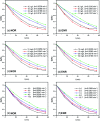Synthesis and application of Bi2WO6 for the photocatalytic degradation of two typical fluoroquinolones under visible light irradiation
- PMID: 35530482
- PMCID: PMC9070762
- DOI: 10.1039/c9ra04445k
Synthesis and application of Bi2WO6 for the photocatalytic degradation of two typical fluoroquinolones under visible light irradiation
Abstract
Bismuth tungstate (Bi2WO6) was successfully synthesized by a method combining ultrasonic solvothermal treatment and high-temperature calcination. The products were affirmed by X-ray diffraction, scanning electron microscopy, UV-vis diffuse reflection spectroscopy, X-ray photoelectron spectroscopy, and Fourier transform infrared spectroscopy. The characterization results indicated that calcination could improve the crystallinity and visible light utilization capacity of Bi2WO6. The photodegradation experiments showed that Bi2WO6 calcined at 450 °C for 3 h exhibited better photocatalytic activity for the degradation of norfloxacin and enrofloxacin under visible light irradiation than the catalyst prepared without calcination or calcined at other temperatures. Meanwhile, the effects of the amount of 450-Bi2WO6, the initial concentration of targets, and the pH of the solutions on the degradation were studied. Under the optimal conditions, the removal ratios reached to 92.95% (for norfloxacin) and 94.58% (for enrofloxacin) within 75 min. Furthermore, h+ and ·O2 - were identified to affect the photodegradation process significantly, and the possible photocatalytic mechanism was proposed. The as-prepared sample was verified to possess good stability and reusability, suggesting its potential application prospect in the treatment of fluoroquinolone antibiotics.
This journal is © The Royal Society of Chemistry.
Conflict of interest statement
The authors declare no competing financial interest.
Figures











Similar articles
-
Synthesis of γ-Fe2O3/La/Bi2WO6 composites for enhanced visible light-driven photocatalytic degradation of tetracycline hydrochloride.Environ Sci Pollut Res Int. 2022 Oct;29(46):69785-69797. doi: 10.1007/s11356-022-20632-0. Epub 2022 May 16. Environ Sci Pollut Res Int. 2022. PMID: 35578074
-
Novel Br-doped Bi2WO6 photocatalyst for high-efficiency removal of norfloxacin: mechanism and photocatalytic activity.Environ Sci Pollut Res Int. 2024 Sep;31(44):56210-56226. doi: 10.1007/s11356-024-34908-0. Epub 2024 Sep 11. Environ Sci Pollut Res Int. 2024. PMID: 39259328
-
Synthesis of Bi2WO6/Bi2O3 composite with enhanced photocatalytic activity by a facile one-step hydrothermal synthesis route.Photochem Photobiol. 2015 Mar-Apr;91(2):291-7. doi: 10.1111/php.12409. Epub 2015 Jan 14. Photochem Photobiol. 2015. PMID: 25530315
-
Bismuth tungstate Bi2WO6: a review on structural, photophysical and photocatalytic properties.RSC Adv. 2023 Jun 9;13(26):17476-17494. doi: 10.1039/d3ra01987j. eCollection 2023 Jun 9. RSC Adv. 2023. PMID: 37304811 Free PMC article. Review.
-
Research progress, trends, and updates on pollutants removal by Bi2WO6-based photocatalysts under visible light irradiation.Heliyon. 2024 Feb 25;10(5):e27115. doi: 10.1016/j.heliyon.2024.e27115. eCollection 2024 Mar 15. Heliyon. 2024. PMID: 38444513 Free PMC article. Review.
Cited by
-
Characterization and Evaluation of Layered Bi2WO6 Nanosheets as a New Antibacterial Agent.Antibiotics (Basel). 2021 Sep 3;10(9):1068. doi: 10.3390/antibiotics10091068. Antibiotics (Basel). 2021. PMID: 34572651 Free PMC article.
-
Bismuth-based nanostructured photocatalysts for the remediation of antibiotics and organic dyes.Beilstein J Nanotechnol. 2023 Mar 3;14:291-321. doi: 10.3762/bjnano.14.26. eCollection 2023. Beilstein J Nanotechnol. 2023. PMID: 36895441 Free PMC article. Review.
-
Synthesis of Co3O4 Nanoparticles-Decorated Bi12O17Cl2 Hierarchical Microspheres for Enhanced Photocatalytic Degradation of RhB and BPA.Int J Mol Sci. 2022 Nov 30;23(23):15028. doi: 10.3390/ijms232315028. Int J Mol Sci. 2022. PMID: 36499352 Free PMC article.
-
A combined first principles and experimental approach to Bi2WO6.RSC Adv. 2023 Dec 12;13(51):36130-36143. doi: 10.1039/d3ra06648g. eCollection 2023 Dec 8. RSC Adv. 2023. PMID: 38090076 Free PMC article.
-
Immobilization of Bi2WO6 on Polymer Membranes for Photocatalytic Removal of Micropollutants from Water - A Stable and Visible Light Active Alternative.Glob Chall. 2024 Feb 28;8(3):2300198. doi: 10.1002/gch2.202300198. eCollection 2024 Mar. Glob Chall. 2024. PMID: 38486926 Free PMC article.
References
-
- Wang J. J. Tang L. Zeng G. M. Zhou Y. Y. Deng Y. C. Fan C. Z. Gong J. L. Liu Y. N. Trans. Nonferrous Met. Soc. China. 2017;27:1794–1803.
LinkOut - more resources
Full Text Sources

